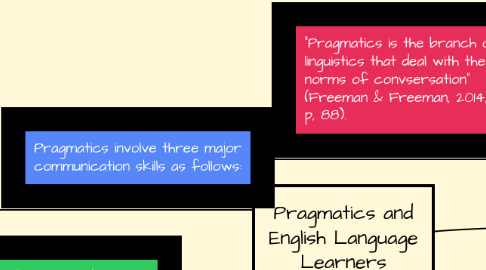Pragmatics and English Language Learners
da James N


1. Idea 1: Present "what would you do" scenarios in classroom. This would help students understand how to properly approach situations and converse given the scenario (greeting, apologizing, thanking, complimenting, etc). The more real life experience with guidance of an educator will help alleviate any misunderstanding.
2. Pragmatics involve three major communication skills as follows:
2.1. Using language for different purposes (greetings, giving information, etc)
2.1.1. Text book p. 55-60
2.2. Changing language according to the needs of a listener or situation (changing what and how we say things based on audience)
2.3. Following rules for conversations and storytelling (taking turns)
3. "Pragmatics is the branch of linguistics that deal with the norms of convsersation" (Freeman & Freeman, 2014, p, 88).
3.1. Spanish
3.1.1. New vocabulary
4. Idea 2: Take trips to local establishments. Students may go shopping or run errands with family who only speak home language. Immersing students in an everyday environment such as shopping, banking, etc. will give students real life experience that will help them understand the rules of pragmatics.
4.1. Physics
4.1.1. Research and prepare experiment
5. Idea 3: Watch videos to analyze how people communicate in given situations. Students will look closely at body language, what someone says and how they say it. This would enable authentic discussions and let students share out thinking.
5.1. Spanish
5.1.1. Midterm
6. ELLs may have difficulty with the following
6.1. Greeting
6.1.1. Text book, exercises 34, 35, 36, 37
